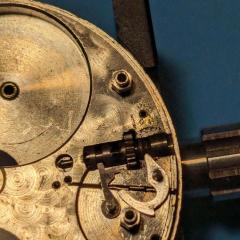Manual wind watch runs for a few hours then stops
-
Recently Browsing
- No registered users viewing this page.
-
Topics
-
Posts
-
By Neverenoughwatches · Posted
Den / Dennison is a unit measurement of size this is actually a mainspring gauge . I haven't heard of a pivot been measured in Dennison before. Though the small thickness gauge is usually supplied with a Jacot tool and is more accurately known as a pivot destroyer. -
Could it be an abbreviation for Denier? "Denier (/ˈdɛniər/) or den (abbreviated D), a unit of measure for the linear mass density of fibers, is the mass in grams per 9,000 metres of the fiber. The denier is based on a natural reference: a single strand of silk is approximately one denier; a 9,000-metre strand of silk weighs about one gram." The pivot gauge looks interesting, however I wouldn't trust myself to drive a pivot into a wedge incase it jams and gets damaged/snaps trying to get it free. More a comment on my ability and incompetence than the quality or design of the tool 🤣
-
As I've seen multiple posts here about multiple types of cleaning solvents, I've done little more than confuse myself more thoroughly that I was before. To see if I understand things correctly... 1. Is One dip is a solvent which is a cleaner and also a protective rinse for hairsprings jewels and pallet stones only? Or can it be used on all the parts (like the case and wheels and all the things) It seems like that would be much easier as it's just "one dip" but it is very expensive. 2. Isopropyl alcohol is a great cleaner for manual cleaning or ultrasonic cleaning (only enclosed jar) just not on pallet fork as it may loosen the shellac holding the stones. Does it have to be 99%? 3. When buying a small manual cleaning brushes, does anybody suggest a certain material of the brush itself?
-
I am new to the new to the watch restoration hobby I have the basic tools. I'm here to learn new things. And utilize my resources (you guys) to expand my knowledge and hopefully save some derelict timepieces from the trash.
-
@Knebo It does make sense. Most companies are trying to squeeze independents out. Maybe I wasn't clear and complete. He said, the mid-case has been polished, he says it was probably to remove pitting. - It kind of makes sense to me, as the pitting on the caseback doesn't match the story of the mid-case. - The case is clearly overpolished and the lugs nicely brushed without any marks, so watchmakers are clearly polishing that area the question is how and how much. I am swarmed with work and will be visiting my watchmaker in a few days with the checklist and will post an update then. You have been really helpful. PS. Refer to the pictures in my latest comment for reference to this and the case at 9'o clock is actually sunk. the drawing is a bit hyperbolic.
-





Recommended Posts